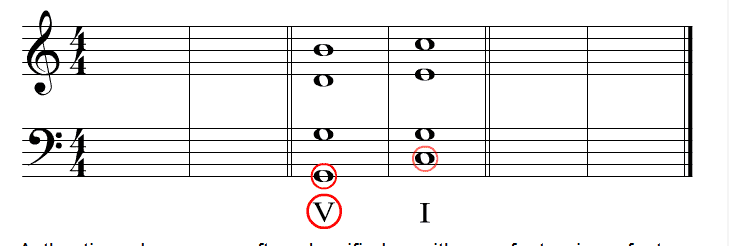A phrase is a series of notes that sound complete even when played apart from the main song.

We will use this musical example to demonstrate phrases. Play the first two measures, notice how they sound incomplete.

Now play the first four measures, they sound more complete. These measures could be considered a phrase.

Play the fifth through eighth measures.Due to their completeness, they also form a phrase.

A cadence is a two-chord progression that occurs at the end of a phrase.

If a phrase ends with any chord going to V, a half cadence (HC) occurs.

Replay the first four measures and notice the sound of the half cadence.

Most people will hear a half cadence as sounding incomplete. Hence, composers usually follow them with a phrase ending in an authentic cadence (AC). An authentic cadence occurs whenever a phrase ends with
V or
viio going to
I (or
i if minor).

Authentic cadences are often classified as either perfect or imperfect.

To be considered a perfect authentic cadence (PAC), the cadence must meet three requirements.

First,
V must be used rather than
viio.

Second, both chords must be in root position.

Finally, the highest note of the
I (or
i) chord must be the tonic of the scale.

An imperfect authentic cadence (IAC) fails to meet these requirements.

These authentic cadences are all imperfect due to various reasons.

In the first example, a
viio is used instead of a
V.

In the second example, one of the chords is not in root position.

In the third example, the highest note of the
I chord is not the tonic of the scale.

In addition to authentic and half cadences, two other kinds exist.

If a phrase ends with IV (or iv) going to I (or i), a plagal cadence (PC) occurs.

If a phrase ends with V going to a chord other than I (or i), a deceptive cadence (DC) occurs.

A deceptive cadence is often used in place of an authentic cadence.

Recall the musical example used at the beginning of this lesson. Let's replace the authentic cadence at the end of the second phrase with a deceptive cadence.Notice how the cadence ''deceives'' you (since you are expecting to hear a I).

Use this chart to reference cadences.

























